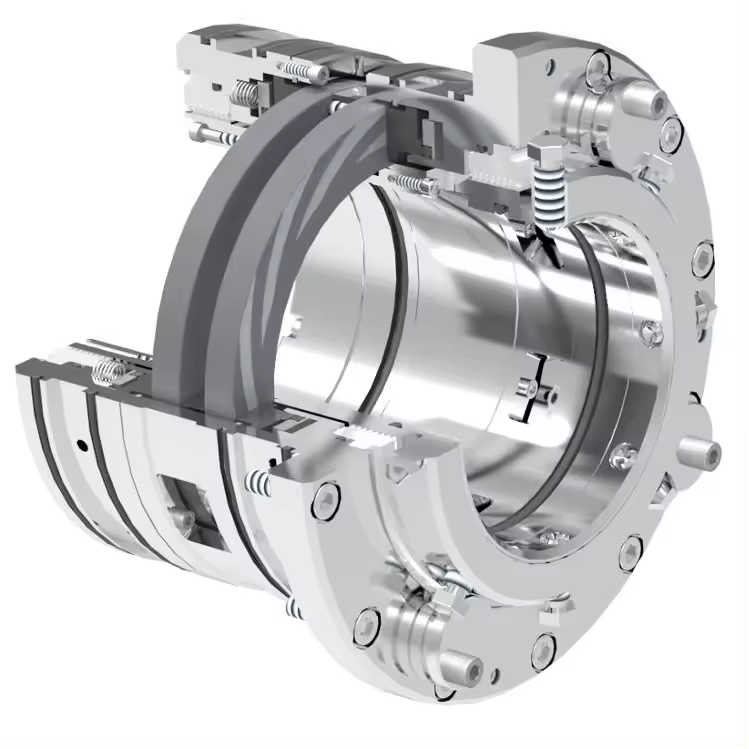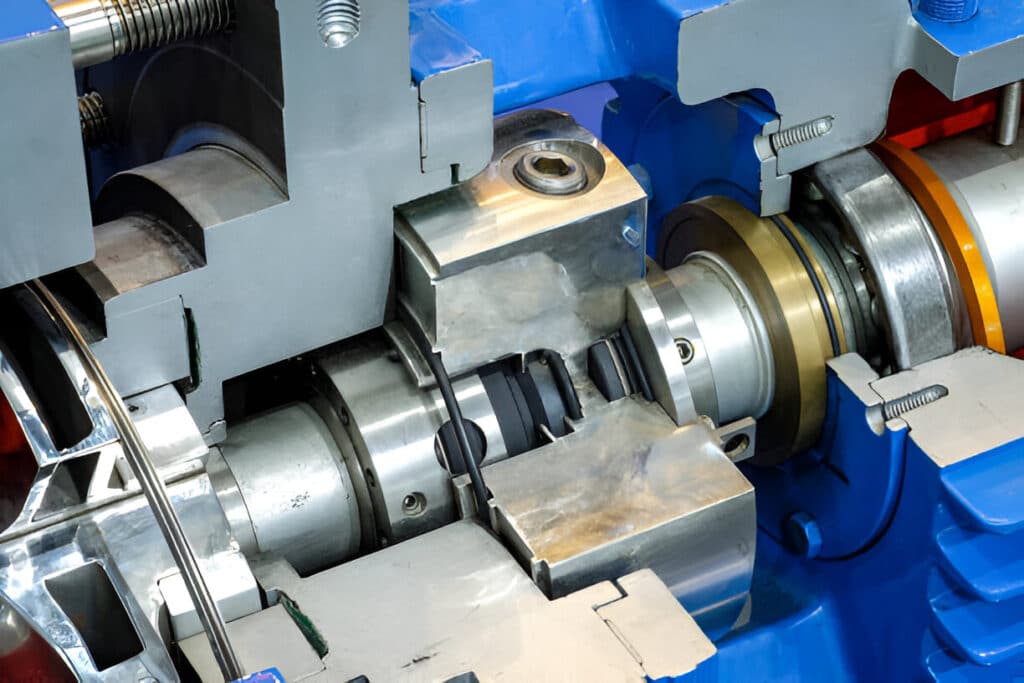
Early Mechanical Seals (1900s-1940s)
Early seal designs, materials (steel, bronze), and applications
Early mechanical seals were primarily made of materials like steel and bronze. These materials were chosen for their durability and resistance to wear. The seals were designed to fit into the stuffing boxes of pumps and other rotating equipment, providing a more effective means of preventing fluid leakage than traditional soft packing.
Invention of the first mechanical seal by George Cook in 1905 (the “Cook Seal”)
The history of mechanical seals began in 1905 when George Cook invented the first mechanical seal, known as the “Cook Seal.” This groundbreaking design consisted of a stationary and a rotating ring, with one ring having a groove filled with a soft packing material. The Cook Seal was a remarkable step forward in sealing technology, offering a more effective and reliable alternative to traditional stuffing box packing.
Development of the “Ryan Seal” by J.M. Ryan of Crane Packing Company in 1929
In 1929, J.M. Ryan of the Crane Packing Company introduced the “Ryan Seal,” which featured a spring-loaded stationary seal face made of carbon graphite and a rotating seal face made of bronze. This design improved upon the Cook Seal by providing better sealing performance and longer service life. The Ryan Seal quickly gained popularity in various industrial applications, particularly in centrifugal pumps.
Advancements in the Mid-20th Century (1950s-1970s)
Introduction of new seal face materials like carbon-graphite, tungsten carbide, ceramics
During the 1950s and 1960s, mechanical seal manufacturers began experimenting with new seal face materials to improve performance and durability. Carbon graphite became a popular choice for stationary seal faces due to its excellent wear resistance and self-lubricating properties. Tungsten carbide and ceramics, such as silicon carbide, were also introduced as seal face materials, offering superior hardness and chemical resistance compared to traditional bronze and steel.
Development of the pressure-velocity (PV) factor by Herbert Hummer of Durametallic
In the 1960s, Herbert Hummer of Durametallic Corporation developed the pressure-velocity (PV) factor, a critical design parameter that relates the sealing pressure and sliding velocity of the seal faces. The PV factor allowed seal manufacturers to optimize seal designs for specific applications, considering factors such as fluid properties, temperature, and pressure. This development led to the creation of more efficient and reliable mechanical seals.
Emergence of standard cartridge seals and seal arrangements (single, double, tandem)
The introduction of standard cartridge seals in the 1960s revolutionized the mechanical sealing industry. Cartridge seals were pre-assembled units that included all the necessary components, such as seal faces, secondary sealing elements, and springs, in a single, ready-to-install package. This design simplified seal installation and maintenance, reducing downtime and costs associated with seal replacements.
During this period, various seal arrangements were also developed to cater to different application requirements. Single seals, consisting of one pair of seal faces, became the most common arrangement for general-purpose applications. Double seals, featuring two pairs of seal faces with a barrier fluid between them, were introduced for more demanding applications requiring higher levels of safety and reliability. Tandem seals, with two pairs of seal faces arranged in series, were developed for applications where a backup seal was necessary in case of primary seal failure.
Founding of major seal companies like John Crane, Flowserve, Burgmann
The mid-20th century saw the emergence of several major mechanical seal manufacturers that would go on to shape the industry. John Crane, founded in 1917, became a leading global supplier of mechanical seals and sealing systems. Flowserve Corporation, formed through the merger of BW/IP and Durco International in 1997, traces its roots back to the Byron Jackson Company, a prominent pump and seal manufacturer founded in 1872. Burgmann Industries, established in 1884, grew to become a major player in the European mechanical sealing market.
These companies played a significant role in advancing mechanical seal technology through continuous investment in research and development, introducing innovative designs, materials, and manufacturing processes that set new standards for sealing performance and reliability.
Modern Era of Mechanical Seals (1980s-Present)
Improvements in seal design and materials driven by stricter regulations and industry demands
In the 1980s and 1990s, increasing environmental concerns and stricter regulations regarding emissions and leakage from industrial equipment drove significant advancements in mechanical seal design and materials. The U.S. Clean Air Act Amendments of 1990, for example, mandated the reduction of volatile organic compound (VOC) emissions from pumps and other equipment, pushing seal manufacturers to develop more efficient and environmentally friendly sealing solutions.
Industry demands for higher reliability, longer service life, and improved performance in challenging conditions also spurred innovation in seal design and materials. Seal manufacturers focused on developing advanced seal face materials, optimizing seal geometry, and incorporating features like spiral grooves and laser-machined face topography to enhance sealing performance and reduce wear.
Use of advanced materials like silicon carbide, diamond coatings, high-performance polymers
The use of advanced materials has been a hallmark of modern mechanical seal development. Silicon carbide, a ceramic material with excellent hardness, wear resistance, and chemical inertness, has become a preferred choice for seal faces in demanding applications involving abrasive or corrosive fluids. Diamond coatings, applied using chemical vapor deposition (CVD) or physical vapor deposition (PVD) techniques, have also been used to enhance the wear resistance and durability of seal faces.
High-performance polymers, such as polytetrafluoroethylene (PTFE), polyether ether ketone (PEEK), and aromatic polyamides (e.g., Kevlar), have been increasingly used in secondary sealing elements and other seal components. These materials offer excellent chemical resistance, low friction, and high-temperature stability, enabling mechanical seals to operate reliably in a wide range of challenging environments.
Integration of features like laser-machined face topography for better performance
Advances in manufacturing technologies have allowed seal manufacturers to incorporate sophisticated features into mechanical seal designs. Laser machining, for example, has enabled the creation of precise micro-topography on seal faces, such as spiral grooves or dimples, which can improve lubrication, reduce friction, and enhance sealing performance.
Other design features that have become more common in modern mechanical seals include:
- Bi-directional sealing capabilities, allowing seals to operate effectively in both directions of rotation
- Self-aligning seal faces, ensuring optimal contact and sealing performance even under misalignment conditions
- Pressure-balanced seal faces, reducing the net closing force on the seal faces and extending seal life
- Flexible graphite secondary sealing elements, offering improved chemical compatibility and high-temperature performance
Adoption of modular cartridge seals and split seals for easier installation and maintenance
Modular cartridge seals have become increasingly popular in recent decades due to their ease of installation and maintenance. These seals are designed with interchangeable components, allowing users to quickly replace worn or damaged parts without having to replace the entire seal assembly. This modular approach reduces downtime and maintenance costs while providing greater flexibility in seal configuration for specific applications.
Split seals, consisting of two halves that can be installed around the shaft without requiring complete disassembly of the equipment, have also gained traction in the sealing industry. Split seals are particularly advantageous for applications where frequent seal maintenance is required or where equipment disassembly is difficult or time-consuming.






